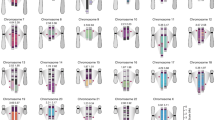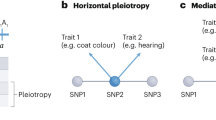Abstract
IN animals with internal fertilization, paternity is uncertain. In birds, the occurrence of copulations outside the pair-bond has been documented in a number of species1,2, but the extent to which these result in illegitimate young is largely unknown, and constitutes a major deficiency in our understanding of avian mating systems3–5. The analysis of tandemly repeated sequences (minisatellites), has enhanced our ability to make individual identifications and paternity determinations6–11. Here we describe the use of a bird minisatellite DNA probe in assigning paternity in natural populaá-tions of the monogamous willow warbler Phylloscopus trochilus and of the polygynous wood warbler Phylloscopus sibilatrix. In both species this probe detects a multiple locus pattern and a single locus that exhibits a variable number of tandem repeats12. Although we observed intrusions by non-resident males into the territories of paired males and extra-pair copulations, no illegitimate offspring were detected among 176 young from 32 families of both species, implying that extra-pair copulations have little or no genetic impact.
This is a preview of subscription content, access via your institution
Access options
Subscribe to this journal
Receive 51 print issues and online access
$199.00 per year
only $3.90 per issue
Buy this article
- Purchase on Springer Link
- Instant access to full article PDF
Prices may be subject to local taxes which are calculated during checkout
Similar content being viewed by others
References
McKinney, F., Cheng, K. M. & Bruggers, D. J. in Sperm Competition and the Evolution of Animal Mating Systems (ed. Smith, R. L.) 523–545 (Academic, Orlando, 1984).
Birkhead, T. R., Atkin, L. & Möller, A. P. Behaviour 101, 101–138 (1987).
Trivers, R. L. in Sexual Selection and the Descent of Man (ed. Campbell, B.) 136–179 (Aldine, Chicago, 1972).
Mock, D. in Perspectives in Ornithology (eds Brush, A. H. & Clark, G. A.) 55–84 (Cambridge University Press, Cambridge and New York, 1983).
Gowaty, P. A. Omithol. Monogr. 37, 11–21 (1985).
Jeffreys, A. J., Wilson, V. & Thein, S. L. Nature 314, 67–73 (1985).
Jeffreys, A. J., Wilson, V. & Thein, S. L. Nature 316, 76–79 (1985).
Jeffreys, A. J., Brookfield, J. F. Y. & Semeonoff, R. Nature 317, 818–819 (1985).
Burke, T. & Bruford, M. W. Nature 327, 149–152 (1987).
Wetton, J. H., Carter, R. E., Parkin, D. T. & Walters, D. Nature 327, 147–149 (1987).
Burke, T., Davies, N. B., Bruford, M. W. & Hatchwell, B. J. Nature 338, 249–252 (1989).
Nakamura, Y. et al. Science 235, 1616–1622 (1987).
Jakobsson, S. thesis, Univ. Stockholm (1987).
Temrin, H. Anim. Behav. 37, 579–586 (1989).
Temrin, H. & Jakobsson, S. Behavl Ecol. Sociobiol. 23, 225–231 (1988).
Alatalo, R. V., Gottlander, K. & Lundberg, A. Behaviour 101, 139–154 (1987).
Gyllensten, U., Jakobsson, S., Temrin, H. & Wilson, A. C. Nucleic Acids Res. 17, 2203–2214 (1989).
Wong, Z., Wilson, V., Patel, I., Povey, S. & Jeffreys, A. J. Ann. Hum. Genet. 51, 269–287 (1987).
Wong, Z., Wilson, V., Jeffreys, A. J. & Thein, S. L. Nucleic Acids Res. 14, 4605–4616 (1986).
Jeffreys, A. J., Royle, N. J., Wilson, V. & Wong, Z. Nature 332, 278–281 (1988).
Burns, J. T., Cheng, K. M. & McKinney, F. Auk 97, 875–879 (1980).
Birkhead, T. R., Pellat, J. & Hunter, F. M. Nature 334, 60–62 (1988).
Westneat, D. F. Anim. Behav. 35, 877–886 (1987).
Sherman P. W. & Morton, M. L. Behavl Ecol. Sociobiol. 22, 413–420 (1988).
Wrege P. H. & Ermlen, S. T. Behavl Ecol. Sociobiol. 20, 153–160 (1987).
Quinn, T. W., Quinn, J. S., Cooke, F. & White, B. N. Nature 326, 392–394 (1987).
Maniatis, T., Fritsch, E. F. & Sambrook, J. Molecular Cloning: A Laboratory Manual (Cold Spring Harbor Laboratory, New York, 1982).
Author information
Authors and Affiliations
Rights and permissions
About this article
Cite this article
Gyllensten, U., Jakobsson, S. & Temrin, H. No evidence for illegitimate young in monogamous and polygynous warblers. Nature 343, 168–170 (1990). https://doi.org/10.1038/343168a0
Received:
Accepted:
Issue Date:
DOI: https://doi.org/10.1038/343168a0
This article is cited by
-
First microsatellite markers for the European Robin (Erithacus rubecula) and their application in analysis of parentage and genetic diversity
Scientific Reports (2021)
-
Multi-scale settlement patterns of a migratory songbird in a European primaeval forest
Behavioral Ecology and Sociobiology (2020)
-
Radical loss of an extreme extra-pair mating system
BMC Ecology (2009)
-
Mate fidelity in a population of Island Canaries (Serinus canaria) in the Madeiran Archipelago
Journal für Ornithologie (2003)
-
The use of DNA fingerprinting to estimate annual survival rates in the Saker Falcon(Falco cherrug)
Journal für Ornithologie (1999)
Comments
By submitting a comment you agree to abide by our Terms and Community Guidelines. If you find something abusive or that does not comply with our terms or guidelines please flag it as inappropriate.



